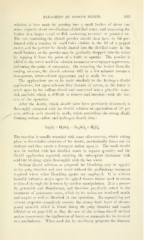Page 555 - My FlipBook
P. 555
BLEACHING BY SODIUM DIOXID. 55S
solution is best made by pouring into a small beaker of about one
ounce capacity about two drachms of distilled water, and immersing the
beaker in a larger vessel or dish containing ice-water or pounded ice.
The can containing the dioxid powder should then have its lid per-
forated with a number of small holes similar to the lid of a pepper
caster, and the powder be slowly dusted into the distilled water in the
small beaker ; or the powder may be gradually dropped into the water
by tapping it from the point of a knife or spatula. The powder is
added to the water until the solution assumes a semi-opaque appearance,
indicating the point of saturation. On removing the beaker from the
cooling mixture, the dioxid solution will in a few minutes assume a
transparent, straw-colored appearance and is ready for use.
The applications are to be made similarly to the hydrogen dioxid
applications, but upon asbestos fiber instead of cotton, as the latter is
acted upon by the sodium dioxid and converted into a glue-like mate-
rial, amyloid, which is difficult to remove and interferes with the suc-
cess of the operation.
After the dentin, which should have been previously desiccated, is
thoroughly saturated with the dioxid solution an application of 10 per
cent, sulfuric acid should be made, which neutralizes the strong alkali^
forming sodium sulfate and hydrogen dioxid, thus :
XaP^ + H,SO, = NagSO, + H2O2.
The reaction is usually attended with some effervescence, which taking
place in the tubular structure of the dentin, mechanically forces out its
contents and thus exerts a detergent action upon it. The tooth should
now be washed with hot distilled water in copious quantity and the
dioxid application repeated, omitting the subsequent treatment with
acid but washing again thoroughly with the hot water.
Sodium dioxid solution, as prepared for bleaching, may be applied
to the pulp chamber and root canal without the preliminary treatment
required where other bleaching agents are employed. It is without
harmful irritative action upon the apical tissues unless used in excess
or foi'ccd through tlie foramen by careless manipulation. It is a power-
ful germicide and disinfectant, and therefore peculiarly suited to the
treatment of putrescent cases, which by its action are rendered sterile
and aseptic as well as bleached at one operation. Its saponifying and
solvent properties completely remove the greasy dark layer of decom-
posed material which is found lining the pulp chamber and canals
alluded to on page 546, so that the use of the sodium dioxid method
makes unnecessary the application of borax or ammonia for its removal
as a preliminary. When used for its sterilizing property the foramen


